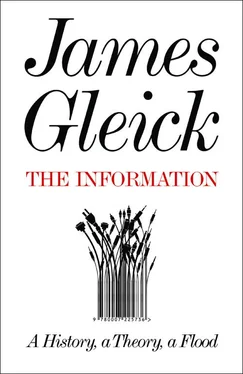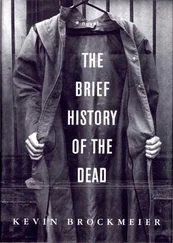is a science of itself, and has its own abstract truth and value; just as logic has its own peculiar truth and value, independently of the subjects to which we may apply its reasonings and processes. . . . One main reason why the separate nature of the science of operations has been little felt, and in general little dwelt on, is the shifting meaning of many of the symbols used.
Symbols and meaning: she was emphatically not speaking of mathematics alone. The engine “might act upon other things besides number .” Babbage had inscribed numerals on those thousands of dials, but their working could represent symbols more abstractly. The engine might process any meaningful relationships. It might manipulate language. It might create music. “Supposing, for instance, that the fundamental relations of pitched sounds in the science of harmony and of musical composition were susceptible of such expression and adaptations, the engine might compose elaborate and scientific pieces of music of any degree of complexity or extent.”
It had been an engine of numbers; now it became an engine of information. A.A.L. perceived that more distinctly and more imaginatively than Babbage himself. She explained his prospective, notional, virtual creation as though it already existed:
The Analytical Engine does not occupy common ground with mere “calculating machines.” It holds a position wholly its own. . . . A new, a vast, and a powerful language is developed . . . in which to wield its truths so that these may become of more speedy and accurate practical application for the purposes of mankind than the means hitherto in our possession have rendered possible. Thus not only the mental and the material, but the theoretical and the practical in the mathematical world, are brought into more intimate and effective connexion with each other.
. . . We may say most aptly, that the Analytical Engine weaves algebraical patterns just as the Jacquard-loom weaves flowers and leaves.
For this flight of fancy she took full responsibility. “Whether the inventor of this engine had any such views in his mind while working out the invention, or whether he may subsequently ever have regarded it under this phase, we do not know; but it is one that forcibly occurred to ourselves.”
She proceeded from the poetic to the practical. She set forth on a virtuoso excursion through a hypothetical program by which this hypothetical machine might compute a famously deep-seated infinite series, the Bernoulli numbers. These numbers arise in the summing of numbers from 1 to n raised to integral powers, and they occur in various guises all through number theory. No direct formula generates them, but they can be worked out methodically, by expanding certain formulas further and further and looking at the coefficients each time. She began with examples; the simplest, she wrote, would be the expansion of
and another approach would be via
but she would take a more challenging path, because “our object is not simplicity . . . but the illustration of the powers of the engine.”
She devised a process, a set of rules, a sequence of operations. In another century this would be called an algorithm, later a computer program, but for now the concept demanded painstaking explanation. The trickiest point was that her algorithm was recursive. It ran in a loop. The result of one iteration became food for the next. Babbage had alluded to this approach as “the Engine eating its own tail.” A.A.L. explained: “We easily perceive that since every successive function is arranged in a series following the same law, there would be a cycle of a cycle of a cycle, &c. . . . The question is so exceedingly complicated, that perhaps few persons can be expected to follow. . . . Still it is a very important case as regards the engine, and suggests ideas peculiar to itself, which we should regret to pass wholly without allusion.”
A core idea was the entity she and Babbage called the variable . Variables were, in hardware terms, the machine’s columns of number dials. But there were “Variable cards,” too. In software terms they were a sort of receptacle or envelope, capable of representing, or storing, a number of many decimal digits. (“What is there in a name?” Babbage wrote. “It is merely an empty basket until you put something in it.”) Variables were the machine’s units of information. This was quite distinct from the algebraic variable. As A.A.L. explained, “The origin of this appellation is, that the values on the columns are destined to change, that is to vary, in every conceivable manner.” Numbers traveled , in effect, from variable cards to variables, from variables to the mill (for operations), from the mill to the store. To solve the problem of generating Bernoulli numbers, she choreographed an intricate dance. She worked days and sometimes through the night, messaging Babbage across London, struggling with sickness and ominous pains, her mind soaring:
That brain of mine is something more than merely mortal; as time will show; (if only my breathing & some other et-ceteras do not make too rapid a progress towards instead of from mortality).
Before ten years are over, the Devil’s in it if I have not sucked out some of the life-blood from the mysteries of this universe, in a way that no purely mortal lips or brains could do.
No one knows what almost awful energy & power lie yet undevelopped in that wiry little system of mine. I say awful , because you may imagine what it might be under certain circumstances. . . .
I am doggedly attacking & sifting to the very bottom, all the ways of deducing the Bernoulli Numbers. . . . I am grappling with this subject, & connecting it with others.
She was programming the machine. She programmed it in her mind, because the machine did not exist. The complexities she encountered for the first time became familiar to programmers of the next century:
How multifarious and how mutually complicated are the considerations which the working of such an engine involve. There are frequently several distinct sets of effects going on simultaneously; all in a manner independent of each other, and yet to a greater or less degree exercising a mutual influence. To adjust each to every other, and indeed even to perceive and trace them out with perfect correctness and success, entails difficulties whose nature partakes to a certain extent of those involved in every question where conditions are very numerous and inter-complicated.
She reported her feelings to Babbage: “I am in much dismay at having got into so amazing a quagmire & botheration.” And nine days later: “I find that my plans & ideas keep gaining in clearness, & assuming more of the crystalline & less & less of the nebulous form.” She knew she had achieved something utterly new. Ten days later still, struggling over the final proofs with “Mr Taylors Printing Office” in Fleet Street, she declared: “I do not think you possess half my forethought, & power of foreseeing all possible contingencies ( probable & improbable , just alike).— . . . I do not believe that my father was (or ever could have been) such a Poet as I shall be an Analyst; (& Metaphysician); for with me the two go together indissolubly.”
Who would have used this machine? Not clerks or shopkeepers, said Babbage’s son, many years later. Common arithmetic was never the purpose—“It would be like using the steam hammer to crush the nut.” He paraphrased Leibniz: “It is not made for those who sell vegetables or little fishes, but for observatories, or the private rooms of calculators, or for others who can easily bear the expense, and need a good deal of calculation.” Babbage’s engine had not been well understood, not by his government and not by the many friends who passed through his salon, but in its time its influence traveled far.
Читать дальше











